
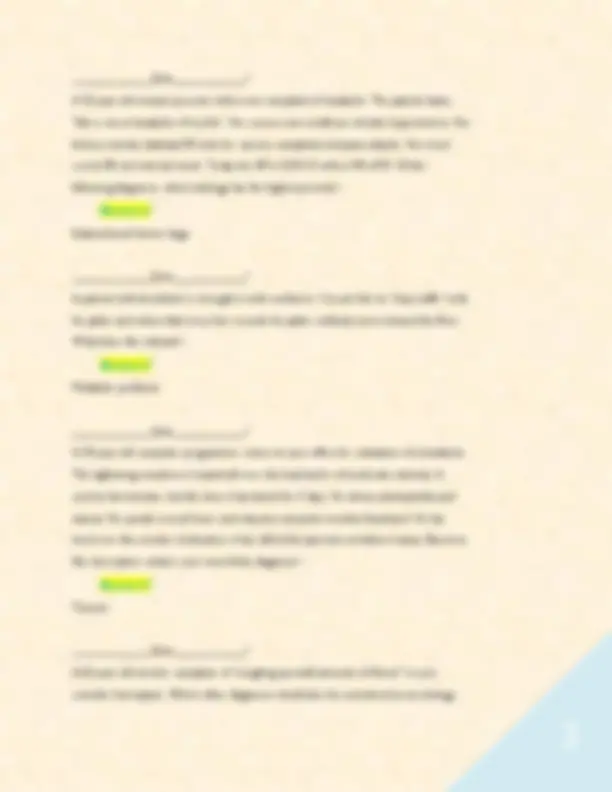
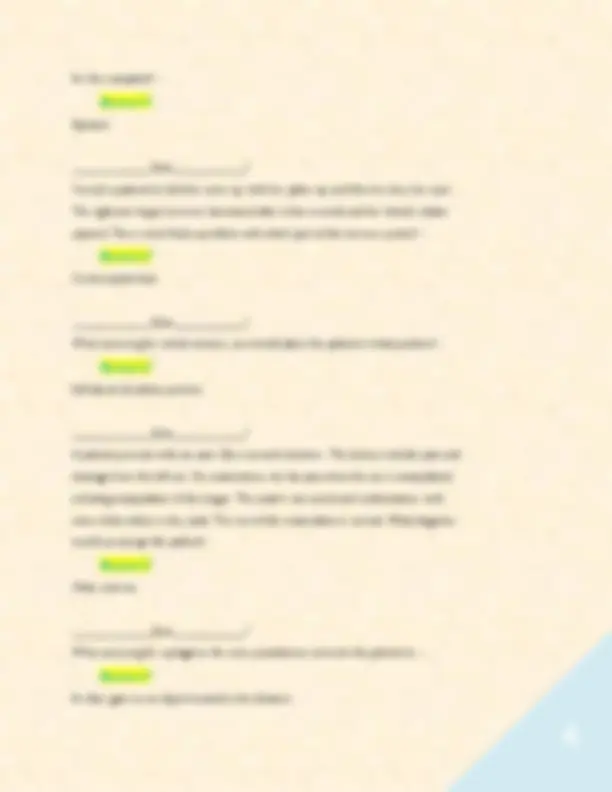
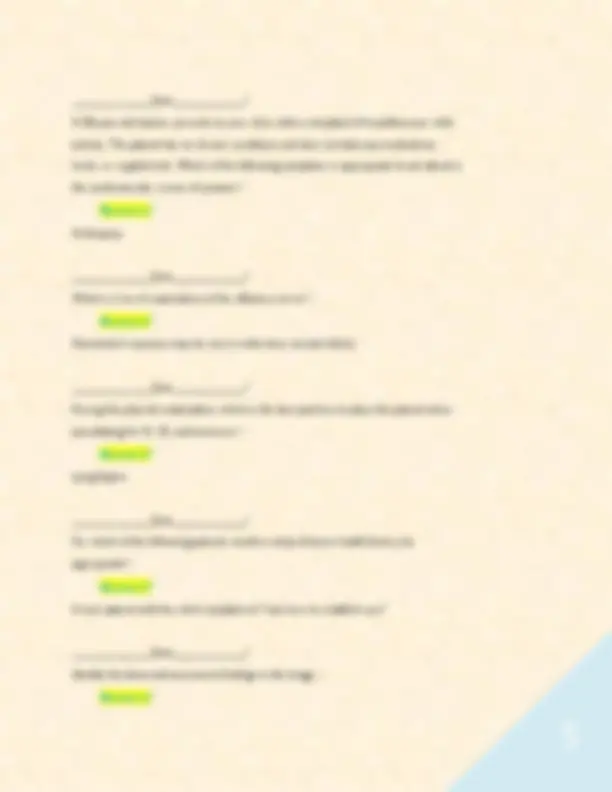
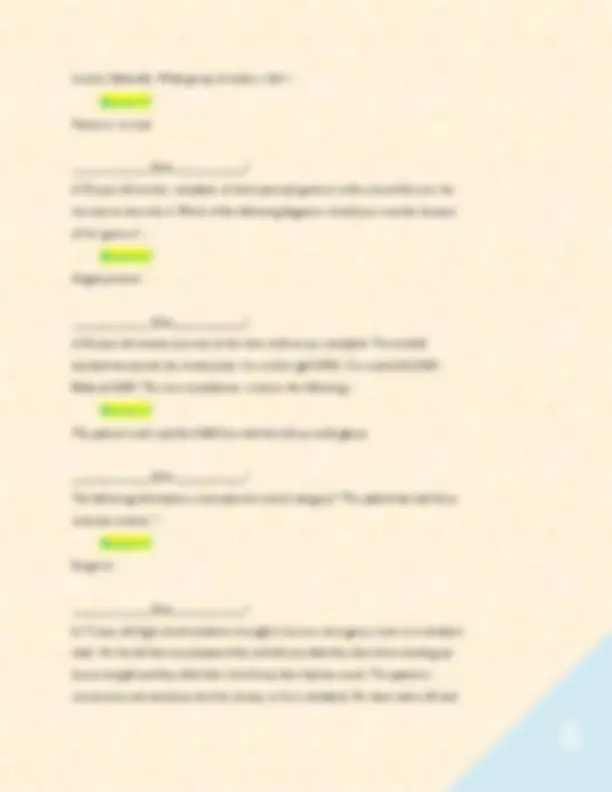
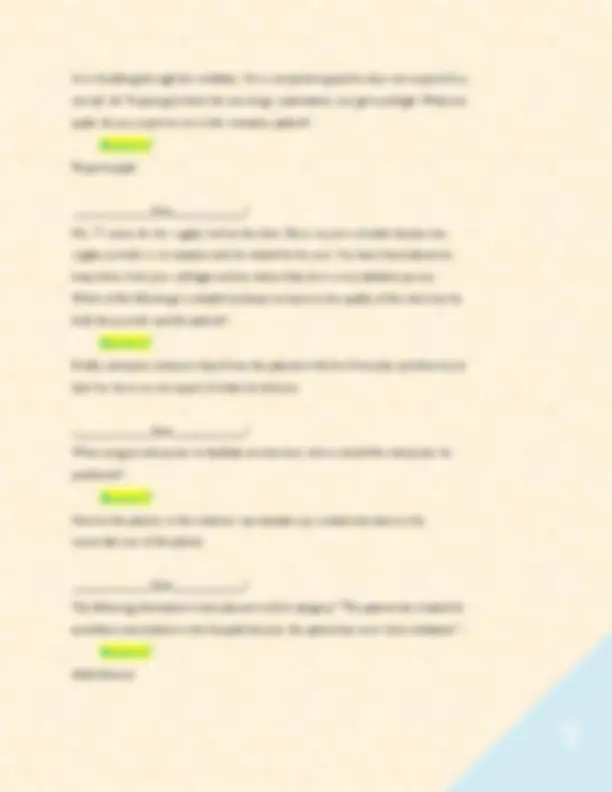
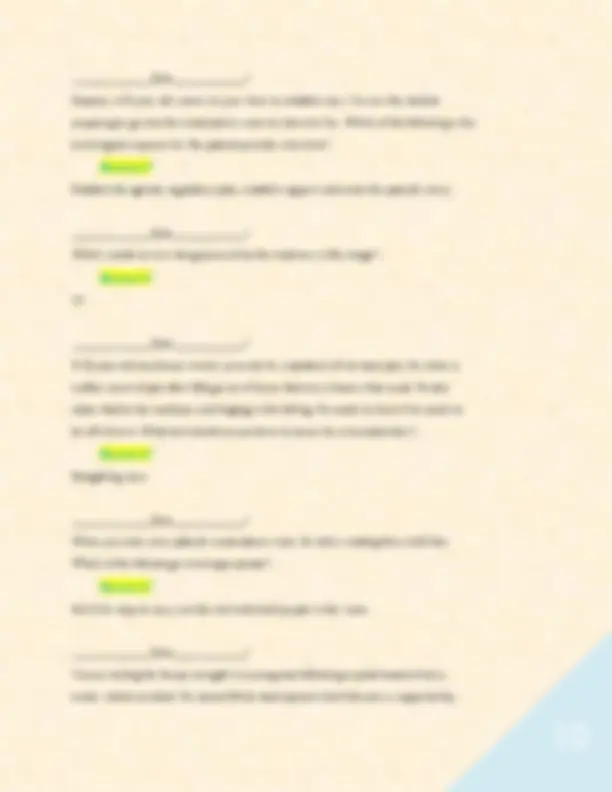
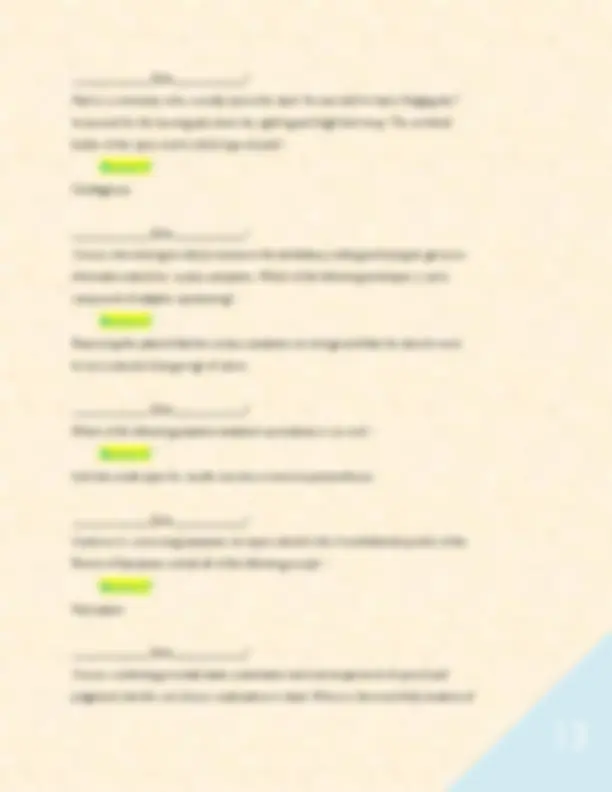
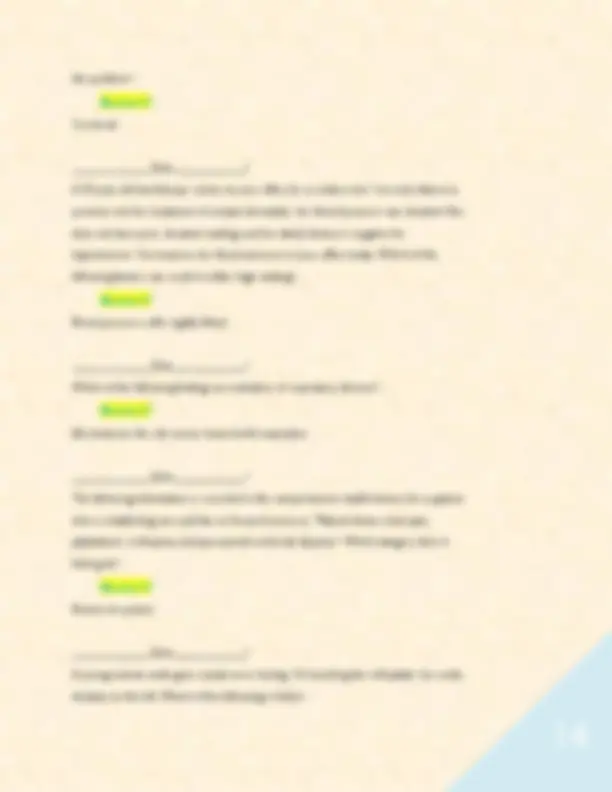
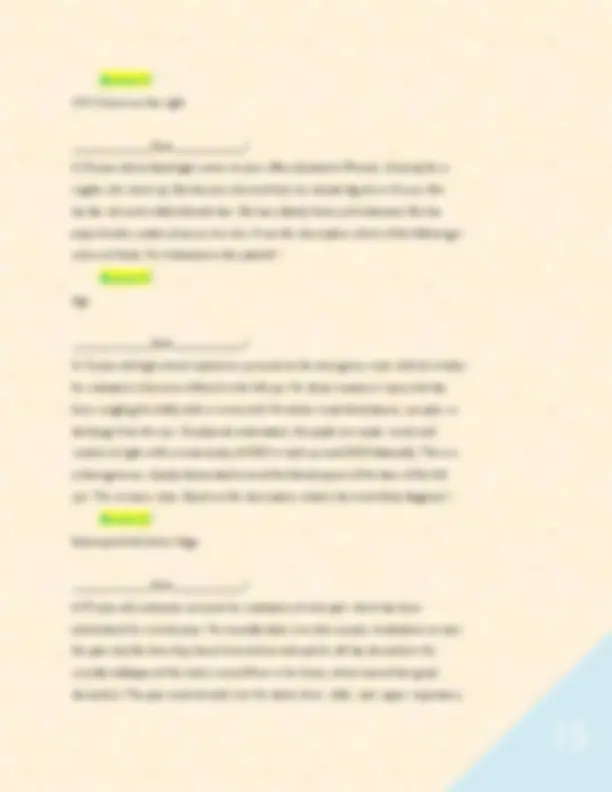
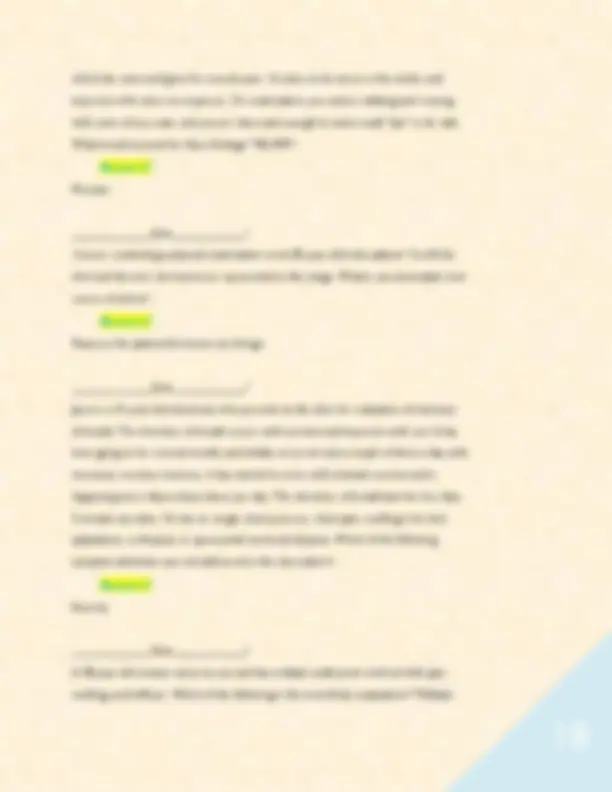
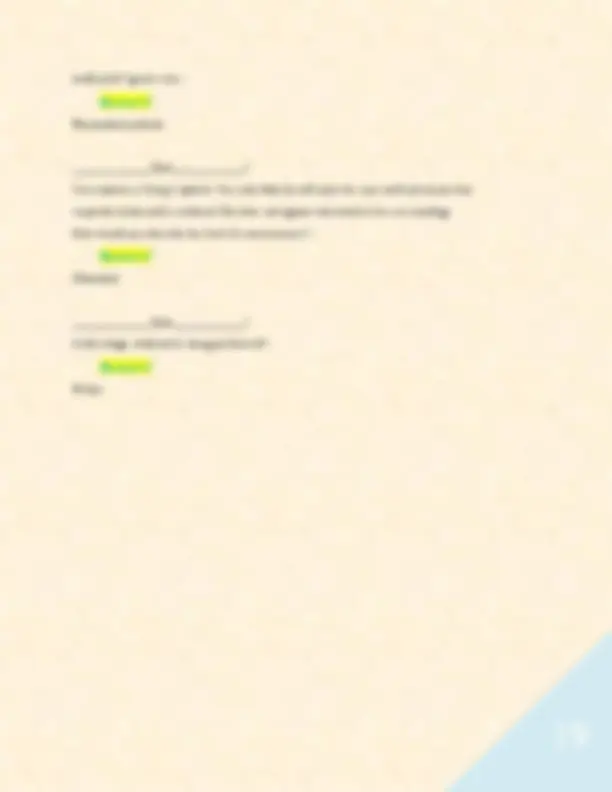


Study with the several resources on Docsity

Earn points by helping other students or get them with a premium plan


Prepare for your exams
Study with the several resources on Docsity

Earn points to download
Earn points by helping other students or get them with a premium plan
Community
Ask the community for help and clear up your study doubts
Discover the best universities in your country according to Docsity users
Free resources
Download our free guides on studying techniques, anxiety management strategies, and thesis advice from Docsity tutors
Midterm Chamberlain NR 509 / NR 509: Comprehensive Expert Strategies, Review of Key Quizzes, and Practice Questions for Guaranteed Success, 2025/2026 Terms in this set (72) _____________Quiz____________? An 18-year-old patient comes to the office for evaluation of a rash. At first there was only one large patch, but then more lesions erupted suddenly on the back and torso; the lesions itch. On physical examination, you note that the pattern of eruption is like a Christmas tree and that there are a variety of erythematous papules and macules on the cleavage lines of the back. Based on this description, what is the most likely diagnosis? - Answer✓✓ Pityriasis rosea _____________Quiz____________? A 19-year-old construction worker presents for ev
Typology: Exams
1 / 19

This page cannot be seen from the preview
Don't miss anything!












Terms in this set (72) _____________Quiz____________? An 18-year-old patient comes to the office for evaluation of a rash. At first there was only one large patch, but then more lesions erupted suddenly on the back and torso; the lesions itch. On physical examination, you note that the pattern of eruption is like a Christmas tree and that there are a variety of erythematous papules and macules on the cleavage lines of the back. Based on this description, what is the most likely diagnosis? -
Pityriasis rosea _____________Quiz____________? A 19-year-old construction worker presents for evaluation of a rash. He notes that it started on his back with a multitude of spots and is also on his arms, chest, and neck. It itches a lot. He does sweat more than before because being outdoors is part of his job. On physical examination, you note dark tan patches with a reddish cast that has sharp borders and fine scales, scattered more prominently around the upper back, chest, neck, and upper arms as well as under the arms. Based on this description, what is your most likely diagnosis? -
Tinea versicolor _____________Quiz____________? You are examining a child with severe cerebral palsy. When you suddenly move his foot dorsally, a sustained "beating" of the foot against your hand ensues. What does this represent? -
Clonus _____________Quiz____________? A patient presents with a daily headache which has worsened over the past several months. On funduscopic examination, you notice that the disk edge is indistinct and the veins do not pulsate. Which is most likely? -
Increased intracranial pressure _____________Quiz____________? A patient complains of epistaxis. Which other cause should be considered? -
Hematemesis _____________Quiz____________? A patient complains of shortness of breath for the past few days. On examination, you note late inspiratory crackles in the lower third of the chest that were not present a week ago. What is the most likely explanation for these? -
Heart failure _____________Quiz____________? You are excited about a positive test finding you have just noticed on physical examination of your patient. You go on to do more examination, laboratory work, and diagnostic tests, only to find that there is no sign of the disease you thought would correlate with the finding. This same experience happens several times. What should you conclude? -
Continue using the test, perhaps doing less laboratory work and diagnostics.
for the complaint? -
Epistaxis _____________Quiz____________? You ask a patient to hold her arms up, with her palms up, and then to close her eyes. The right arm begins to move downward after a few seconds and her thumb rotates upward. This is most likely a problem with which part of the nervous system? -
Corticospinal tract _____________Quiz____________? When assessing for mitral stenosis, you should place the patient in what position? -
left lateral decubitus position _____________Quiz____________? A patient presents with ear pain. She is an avid swimmer. The history includes pain and drainage from the left ear. On examination, she has pain when the ear is manipulated, including manipulation of the tragus. The canal is narrowed and erythematous, with some white debris in the canal. The rest of the examination is normal. What diagnosis would you assign this patient? -
Otitis externa _____________Quiz____________? When assessing for nystagmus the nurse practitioner instructs the patient to: -
fix their gaze on an object located in the distance
_____________Quiz____________? A 58-year-old teacher presents to your clinic with a complaint of breathlessness with activity. The patient has no chronic conditions and does not take any medications, herbs, or supplements. Which of the following symptoms is appropriate to ask about in the cardiovascular review of systems? -
Orthopnea _____________Quiz____________? Which is true of examination of the olfactory nerve? -
Diminished responses may be seen in otherwise normal elderly. _____________Quiz____________? During the physical examination, which is the best position to place the patient when auscultating for S1, S2, and murmurs? -
Lying Supine _____________Quiz____________? For which of the following patients would a comprehensive health history be appropriate? -
A new patient with the chief complaint of "I am here to establish care" _____________Quiz____________? Identify the abnormal assessment findings in this image. -
leading cause of blindness overall. What features would be noted on funduscopic examination? -
Increased cup-to-disc ratio _____________Quiz____________? A patient is examined with the ophthalmoscope and found to have red reflexes bilaterally. Which of the following diagnoses is still a potential concern? -
Hypertensive retinopathy _____________Quiz____________? A 7-year-old boy is performing poorly in school. His teacher is frustrated because he is frequently seen "staring off into space" and not paying attention. If this is a seizure, it most likely represents which type? -
Absence _____________Quiz____________? You have just asked a patient how he feels about his emphysema. He becomes silent, folds his arms across his chest and leans back in his chair, and then replies, "It is what it is." How should you respond? -
"You seem bothered by this question." _____________Quiz____________? A college student presents with a sore throat, fever, and fatigue for several days. You notice exudates on her enlarged tonsils. You do a careful lymphatic examination and notice some scattered small, mobile lymph nodes just behind her sternocleidomastoid
muscles bilaterally. What group of nodes is this? -
Posterior cervical _____________Quiz____________? A 55-year-old smoker complains of chest pain and gestures with a closed fist over her sternum to describe it. Which of the following diagnoses should you consider because of her gesture? -
Angina pectoris _____________Quiz____________? A 65-year-old woman presents to the clinic with an eye complaint. The medical assistant documents the visual acuity: Corrected right 20/40; Corrected left 20/60; Bilateral 20/60. The nurse practitioner surmises the following: -
The patient could read the 20/60 line with the left eye with glasses _____________Quiz____________? The following information is best placed in which category? "The patient has had three cesarean sections." -
Surgeries _____________Quiz____________? A 17-year-old high school student is brought in to your emergency room in a comatose state. His friends have accompanied him and tell you that they have been shooting up heroin tonight and they think their friend may have had too much. The patient is unconscious and cannot protect his airway, so he is intubated. His heart rate is 60 and
_____________Quiz____________? Suzanne, a 25 year old, comes to your clinic to establish care. You are the student preparing to go into the examination room to interview her. Which of the following is the most logical sequence for the patient-provider interview? -
Establish the agenda, negotiate a plan, establish rapport, and invite the patient's story. _____________Quiz____________? Which cranial nerve is being assessed by the examiner in this image? -
_____________Quiz____________? A 32-year-old warehouse worker presents for evaluation of low back pain. He notes a sudden onset of pain after lifting a set of boxes that were heavier than usual. He also states that he has numbness and tingling in the left leg. He wants to know if he needs to be off of work. What test should you perform to assess for a herniated disc? -
Straight-leg raise _____________Quiz____________? When you enter your patient's examination room, his wife is waiting there with him. Which of the following is most appropriate? -
Ask if it's okay to carry out the visit with both people in the room. _____________Quiz____________? You are testing the biceps strength in a young man following a spinal trauma from a motor vehicle accident. He cannot lift his hand upward, but if the arm is supported by
the examiner and abducted to 90 degrees, he can then move his forearm side to side. This would represent which muscle strength grading? -
_____________Quiz____________? Alexandra is a 28-year-old editor who presents to the clinic with abdominal pain. The pain is a dull ache, located in the right upper quadrant, that she rates as a 3 at the least and an 8 at the worst. The pain started a few weeks ago, it lasts for 2 to 3 hours at a time, it comes and goes, and it seems to be worse a couple of hours after eating. She has noticed that it starts after eating greasy foods, so she has cut down on these as much as she can. Initially it occurred once a week, but now it is occurring every other day. Nothing makes it better. From this description, which of the seven attributes of a symptom has been omitted? -
Associated manifestations _____________Quiz____________? A 15-year-old high school sophomore comes to the clinic for evaluation of a 3-week history of sneezing; itchy, watery eyes; clear nasal discharge; ear pain; and nonproductive cough. Which is the most likely pathologic process? -
Allergic _____________Quiz____________? What is responsible for the inspiratory splitting of S2? -
Closure of aortic, then pulmonic valves
_____________Quiz____________? Mark is a contractor who recently injured his back. He was told he had a "bulging disc" to account for the burning pain down his right leg and slight foot drop. The vertebral bodies of the spine involve which type of joint? -
Cartilaginous _____________Quiz____________? You are interviewing an elderly woman in the ambulatory setting and trying to get more information about her urinary symptoms. Which of the following techniques is not a component of adaptive questioning? -
Reassuring the patient that the urinary symptoms are benign and that she doesn't need to worry about it being a sign of cancer _____________Quiz____________? Which of the following anatomic landmark associations is correct? -
2nd intercostal space for needle insertion in tension pneumothorax _____________Quiz____________? Common or concerning symptoms to inquire about in the Constituitional portion of the Review of Symptoms include all of the following except: -
Hemoptysis _____________Quiz____________? You are conducting a mental status examination and note impairment of speech and judgement, but the rest of your examination is intact. Where is the most likely location of
the problem? -
Cerebrum _____________Quiz____________? A 55-year-old bookkeeper comes to your office for a routine visit. You note that on a previous visit for treatment of contact dermatitis, her blood pressure was elevated. She does not have prior elevated readings and her family history is negative for hypertension. You measure her blood pressure in your office today. Which of the following factors can result in a false high reading? -
Blood pressure cuff is tightly fitted. _____________Quiz____________? Which of the following findings are indicative of respiratory distress? -
Skin between the ribs moves inward with inspiration _____________Quiz____________? The following information is recorded in the comprehensive health history for a patient who is establishing care and has no focused concerns: "Patient denies chest pain, palpitations, orthopnea, and paroxysmal nocturnal dyspnea." Which category does it belong to? -
Review of systems _____________Quiz____________? A young woman undergoes cranial nerve testing. On touching the soft palate, her uvula deviates to the left. Which of the following is likely? -
symptoms, trauma, or injury to the neck. Based on this description, what is the most likely pathologic process? -
Degenerative _____________Quiz____________? The following information is recorded in the health history: "The patient completed 8th grade. He currently lives with his wife and two children. He works on old cars on the weekend. He works in a glass factory during the week." Which category does it belong to? -
Personal and social history _____________Quiz____________? Ms. Fields is a pleasant, obese female with a BMI of 39. BP 120/82, HR 80, R 18, Oxygen Saturation 98%. This information is: -
Objective _____________Quiz____________? Two weeks ago, Mary started a job which requires carrying 40-pound buckets. She presents with elbow pain worse on the right. On examination, it hurts her elbows to dorsiflex her hands against resistance when her palms face the floor. What condition does she have? TENNIS ELBOW -
Lateral epicondylitis _____________Quiz____________? A 43-year-old female patient presents with concern about her skin lightening over the
past 3 months. The findings are represented in this image. She denies recent illness or infection. Her physical examination is otherwise unremarkable. Which laboratory study is most important to include with her work-up? -
Thyroid panel consisting of TSH, free T3, and free T4 levels _____________Quiz____________? Mr. Tommie, a 48-year-old African American contractor, reports pain of the right great toe. "Feels like a ton of bricks fell on my foot". The pain extends up his legs. This information is: -
Subjective _____________Quiz____________? The nurse practitioner is assessing a patient's chief complaint of shoulder pain that started about 3 weeks ago. Upon physical exam, findings reveal atrophy of the supraspinatus and increased prominence of the scapular spine, pain with shoulder movement, and a positive drop arm test. The most likely diagnosis for these findings is: -
rotator cuff tendinitis or tear _____________Quiz____________? Common or concerning symptoms to inquire about during the constitutional survey of the ROS include all of the following EXCEPT: -
Cough _____________Quiz____________? A young man comes to you with an extremely pruritic rash over his knees and elbows
small joints* gout is one -
Rheumatoid arthritis _____________Quiz____________? You examine a "sleepy" patient. You note that she will open her eyes and look at you but responds slowly and is confused. She does not appear interested in her surroundings. How would you describe her level of consciousness? -
Obtunded _____________Quiz____________? In this image, what test is being performed? -
Weber